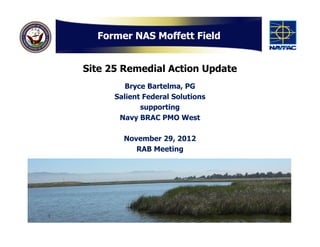Site 25 rab nov 29 2012
- 1. Former NAS Moffett Field Site 25 Remedial Action Update Bryce Bartelma, PG Salient Federal Solutions supporting Navy BRAC PMO West November 29, 2012 RAB Meeting
- 2. IR Site 25 IR Site 25 encompasses approximately 230 acres and was constructed for use as part of the Moffett Field storm water management system since 1953 AOI-14 The Navy is coordinating remedial action activities with NASA as they prepare to conduct their cleanup activities at Area of Investigation (AOI)-14 2
- 3. Remedial Design and Remedial Action Work Plan • Final Remedial Design and Remedial Action Work Plan (RD/RAWP) distributed on March 30 • Removal of over 32,500 cubic yards of sediment from nearly 32 acres • Planned excavation depths of 0.5 – 1.5 feet below ground surface • Restore vegetated areas with pickleweed and other native grass 3
- 4. Temporarily Re-route Storm Water & WATS effluent Storm Water Settling Vault Catch Basin 4
- 5. August 2012 Conditions at IR Site 25 5
- 6. Biological Observations at Site 25 NESTING • Alameda Song Sparrow • Western Harrier • Mockingbird, marsh wren, bushtit and killdeer OBSERVED • Harvest Mice (unidentified subspecies) • Deer Mice & Voles • California Least Tern (in flight) • Black Rail (vocalizing) • Fox, jackrabbit, and gopher snake NOT OBSERVED • Western Pond Turtle (WPT) • Western Snowy Plover • California Clapper Rail 6
- 7. Biological Protection Measures PROTECTION MEASURES 1. Visually inspect/clear vegetation prior to removal 2. Hand remove pickleweed 3. Silt fencing along access points and suitable habitat areas 4. Continuous biological monitoring 5. Coordination with CDFG and USFWS 7
- 8. Sediment Excavations • Planned excavation depths of 0.5 – 1.5 feet below ground surface • Field surveying to verify dig depths • Grid confirmation sampling 8
- 9. Over-excavations • Several samples confirmed additional over-excavation was required • Primarily in Eastern Diked Marsh (EDM) • Depths of up to 5 feet below ground surface (EDM) encountered groundwater 9
- 10. IR Site 25 Remedial Action Facts • Excavation depths of 0.5 to 5.0 feet below ground surface • 36,390 cubic yards of sediment from nearly 32 acres • 19,500 linear feet of biological silt fencing • Utilized up to 14 biologists • Bypassed 15,724,800 gallons of WATS and storm water • 236 confirmation samples • 173 days with up to 40 workers (over 23,502 hours) on site • 2,173 truck loads of sediment transported to landfill 10
- 11. Aerial Imagery 11
- 12. Aerial Imagery 12
- 13. Vegetation Restoration • All vegetation areas removed during Remedial Action will be restored (excludes EDM and Pickleweed inundated mud flats) Salicornia virginica • Two types of hydroseed palettes (High Salt Marsh and Transitional Upland) will be used with majority of seeds including pickleweed and saltgrass • Minimum of two years monitoring Saltgrass and maintenance Distichlis spicata • Options for irrigation services and additional hydroseeding/plantings 13
- 14. Schedule • Sediment Excavations and Disposal Completed • Vegetation Restoration Nov./Dec. 2012 • Vegetation Monitoring Ongoing • Submit Remedial Action Completion Report Spring 2013 14
- 15. Questions? Point of Contact: Scott Anderson BRAC Environmental Coordinator (619) 532-0938 scott.d.anderson@navy.mil 15

